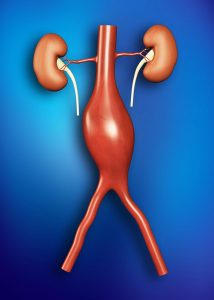Aneurysms are caused by a degenerative condition of the arteries of the body, resulting in expansion and weakness in the arterial wall. Smoking and a family history of aneurysms are the main risk factors. Large aneurysms can rupture with potentially life-threatening consequences. Aneurysms can occur in almost any artery of the body, but most commonly in the abdominal aorta. Once aneurysms reach a size threshold, we advocate pre-emptive treatment to prevent rupture.
EVAR (EndoVascular Aneurysm Repair)
Today, most aortic aneurysms are treated with a stent graft. This is performed under general anaesthesia. Wires are placed from the arteries in the groin through the aneurysm, and the stent graft is inserted and deployed to sit inside the aneurysm. This prevents blood flow into the aneurysm and prevents rupture. Patients usually stay in hospital one or two nights. With a minimally invasive approach, the procedure can be performed with only 1cm incisions in each groin.
